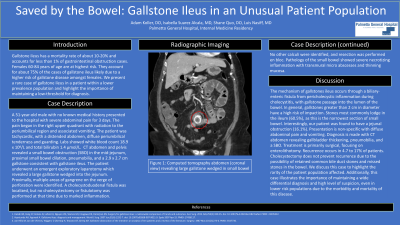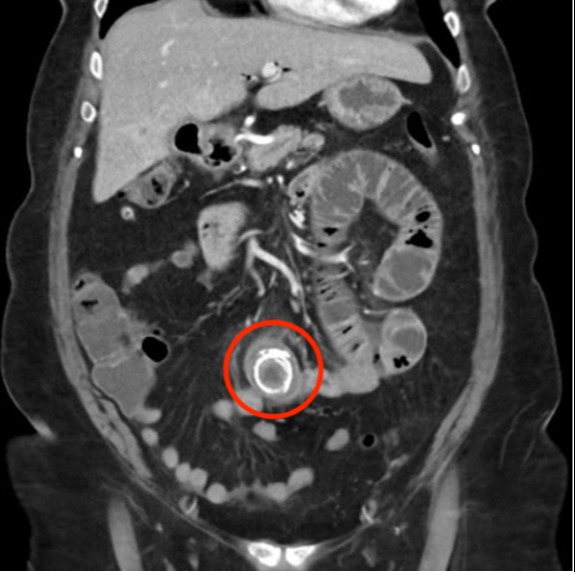Tuesday Poster Session
Category: Small Intestine
P4134 - Saved by the Bowel: Gallstone Ileus in an Unusual Patient Population
Tuesday, October 24, 2023
10:30 AM - 4:00 PM PT
Location: Exhibit Hall

Has Audio

Adam Z. Koller, DO, MS
Palmetto General Hospital
Coral Gables, FL
Presenting Author(s)
Adam Z. Koller, DO, MS1, Isabella Suarez Alcala, MD2, Shane Quo, DO3, Luis Nasiff, MD4
1Palmetto General Hospital, Coral Gables, FL; 2Palmetto General Hospital, Hialeah, FL; 3University of Miami at Holy Cross Hospital, Fort Lauderdale, FL; 4Larkin Community Hospital, Hialeah, FL
Introduction: Gallstone ileus has a mortality rate of about 10-20%, and accounts for less than 1% of gastrointestinal obstruction cases. Females 60-84 years of age are at highest risk. They account for about 75% of the cases of gallstone ileus likely due to a higher risk of gallstone disease amongst females. We present a rare case of gallstone ileus in a patient within a lower prevalence population and highlight the importance of maintaining a low-threshold for diagnosis.
Case Description/Methods: A 51-year-old male with no known medical history presented to the hospital with severe abdominal pain for 3 days. The pain began in the right upper quadrant with radiation to the periumbilical region and associated vomiting. The patient was tachycardic, with a distended abdomen, diffuse periumbilical tenderness and guarding. Labs showed white blood count 18.9 x 109/L and total bilirubin 1.4 µmol/L. CT abdomen and pelvis revealed a small bowel obstruction (SBO) in the mid-jejunum, proximal small bowel dilation, pneumobilia, and a 2.9 x 2.7 cm gallstone consistent with gallstone ileus. The patient underwent an emergent exploratory laparotomy which revealed a large gallstone wedged into the jejunum with gangrenous mucosa on the verge of perforation. Enterolithotomy was performed. A cholecystoduodenal fistula was localized, but no cholecystectomy or fistulotomy was performed at that time due to marked inflammation.
Discussion: The mechanism of gallstones ileus occurs through a biliary-enteric fistula from pericholecystic inflammation during cholecystitis, with gallstone passage into the lumen of the bowel. In general, gallstones greater than 2 cm in diameter have a high risk of impaction. Stones most commonly lodge in the ileum (60.5%), in contrast to our patient who had a jejunal obstruction (16.1%). Presentation is non-specific with abdominal pain and vomiting. Diagnosis is made with CT abdomen revealing gallbladder thickening, pneumobilia, and SBO. Treatment is primarily surgical, focusing on enterolithotomy. Recurrence occurs in 4.7 to 17% of patients. Cholecystectomy does not prevent recurrence due to the possibility of retained common bile duct stones and missed stones in the bowel. We discuss this case to highlight the rarity of the patient population affected. Additionally, this case illustrates the importance of maintaining a wide differential diagnosis and high level of suspicion, even in lower risk populations due to the morbidity and mortality of this disease.

Disclosures:
Adam Z. Koller, DO, MS1, Isabella Suarez Alcala, MD2, Shane Quo, DO3, Luis Nasiff, MD4. P4134 - Saved by the Bowel: Gallstone Ileus in an Unusual Patient Population, ACG 2023 Annual Scientific Meeting Abstracts. Vancouver, BC, Canada: American College of Gastroenterology.
1Palmetto General Hospital, Coral Gables, FL; 2Palmetto General Hospital, Hialeah, FL; 3University of Miami at Holy Cross Hospital, Fort Lauderdale, FL; 4Larkin Community Hospital, Hialeah, FL
Introduction: Gallstone ileus has a mortality rate of about 10-20%, and accounts for less than 1% of gastrointestinal obstruction cases. Females 60-84 years of age are at highest risk. They account for about 75% of the cases of gallstone ileus likely due to a higher risk of gallstone disease amongst females. We present a rare case of gallstone ileus in a patient within a lower prevalence population and highlight the importance of maintaining a low-threshold for diagnosis.
Case Description/Methods: A 51-year-old male with no known medical history presented to the hospital with severe abdominal pain for 3 days. The pain began in the right upper quadrant with radiation to the periumbilical region and associated vomiting. The patient was tachycardic, with a distended abdomen, diffuse periumbilical tenderness and guarding. Labs showed white blood count 18.9 x 109/L and total bilirubin 1.4 µmol/L. CT abdomen and pelvis revealed a small bowel obstruction (SBO) in the mid-jejunum, proximal small bowel dilation, pneumobilia, and a 2.9 x 2.7 cm gallstone consistent with gallstone ileus. The patient underwent an emergent exploratory laparotomy which revealed a large gallstone wedged into the jejunum with gangrenous mucosa on the verge of perforation. Enterolithotomy was performed. A cholecystoduodenal fistula was localized, but no cholecystectomy or fistulotomy was performed at that time due to marked inflammation.
Discussion: The mechanism of gallstones ileus occurs through a biliary-enteric fistula from pericholecystic inflammation during cholecystitis, with gallstone passage into the lumen of the bowel. In general, gallstones greater than 2 cm in diameter have a high risk of impaction. Stones most commonly lodge in the ileum (60.5%), in contrast to our patient who had a jejunal obstruction (16.1%). Presentation is non-specific with abdominal pain and vomiting. Diagnosis is made with CT abdomen revealing gallbladder thickening, pneumobilia, and SBO. Treatment is primarily surgical, focusing on enterolithotomy. Recurrence occurs in 4.7 to 17% of patients. Cholecystectomy does not prevent recurrence due to the possibility of retained common bile duct stones and missed stones in the bowel. We discuss this case to highlight the rarity of the patient population affected. Additionally, this case illustrates the importance of maintaining a wide differential diagnosis and high level of suspicion, even in lower risk populations due to the morbidity and mortality of this disease.

Figure: Coronal View of a 29 mm x 27 mm Gallstone Causing SBO
Disclosures:
Adam Koller indicated no relevant financial relationships.
Isabella Suarez Alcala indicated no relevant financial relationships.
Shane Quo indicated no relevant financial relationships.
Luis Nasiff indicated no relevant financial relationships.
Adam Z. Koller, DO, MS1, Isabella Suarez Alcala, MD2, Shane Quo, DO3, Luis Nasiff, MD4. P4134 - Saved by the Bowel: Gallstone Ileus in an Unusual Patient Population, ACG 2023 Annual Scientific Meeting Abstracts. Vancouver, BC, Canada: American College of Gastroenterology.
